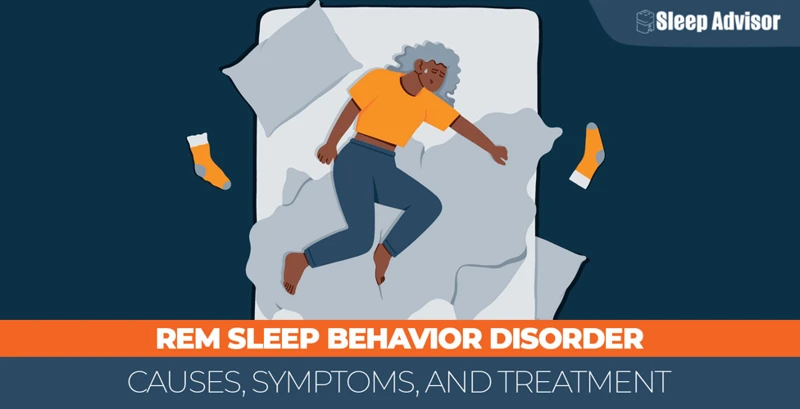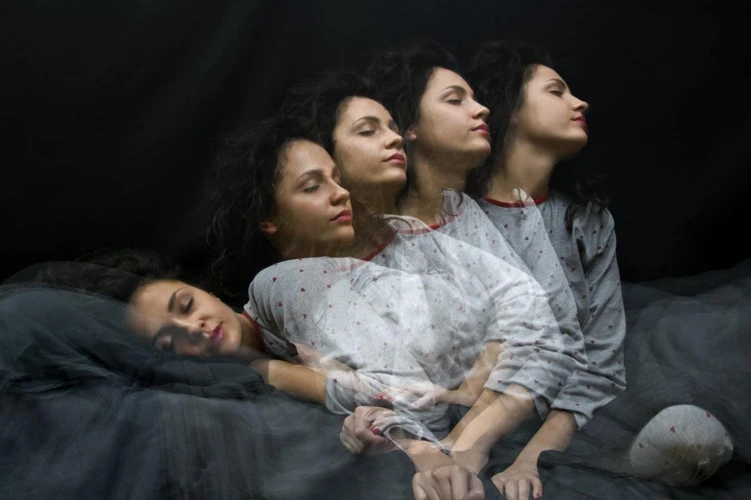As we lay to rest every night, our bodies undergo a series of sleep phases, each with their unique characteristics. One of the most intriguing stages of sleep is the Rapid Eye Movement (REM) phase, often noted for its association with dreams. However, for individuals with REM Sleep Behavior Disorder (RBD), this stage can be a cause for concern. During REM sleep, people with RBD act out their dreams, leading to injury or harm to themselves or their sleeping partner. While the cause of RBD is still unknown, it’s a condition that requires medical attention and can be treated. In this article, we explore the causes and treatments of RBD and the complications that can arise from the condition.
What is REM Sleep Behavior Disorder?

As we drift into slumber, our bodies enter different stages of sleep, each with their own distinct characteristics. Rapid Eye Movement (REM) sleep is one such phase, during which our brains become frenetically active while our muscles are fully relaxed. However, for some individuals, this can cause a potentially dangerous phenomenon known as REM Sleep Behavior Disorder (RBD). With RBD, the normal paralysis of muscles that happens during REM sleep is absent, leading to physical movements and actions that can be harmful or disruptive to both the affected individual and their sleeping partner. Let’s delve deeper into the particulars of this disorder.
Symptoms of RBD
REM Sleep Behavior Disorder (RBD) is a neurological disorder that involves disruptive and anomalous behavior during the dream stage of sleep. Individuals suffering from RBD experience vivid and intense dreams that can cause them to act out physically, leading to potential harm to themselves or their bed partner. Some of the symptoms that can be experienced by individuals with RBD are highlighted in the following table:
| Symptoms of RBD | Description |
|---|---|
| Violent movements during sleep | Individuals with RBD display violent movements while asleep. They may kick, punch, or even jump out of bed during their sleep cycle. |
| Talking during sleep | Individuals with RBD may talk or shout during their sleep cycle due to vivid and intense dreaming. |
| Nightmares | RBD can cause individuals to have frequent nightmares, leading to a fear of sleeping, feeling anxious, and being restless at night. They may even wake up gasping or screaming due to stressful dreams. |
| Physical injury to self or bed partner | Physical movements during sleep can result in injury to individuals with RBD or their bed partner, leading to bruises, lacerations or even fractures. |
| Poor sleep quality | Individuals with RBD may experience poor sleep quality due to constant interruptions, leading to daytime sleepiness, fatigue and overall reduced productivity. |
It is essential to note that while these symptoms may be indicative of RBD, they are not exclusive to the disorder. It is crucial to consult a medical professional for proper diagnosis and treatment.
Who is at Risk?
Several factors can increase the risk of developing REM Sleep Behavior Disorder. Here is a breakdown of who is at higher risk:
| Risk Factors | Description |
|---|---|
| Age | Most commonly affects adults aged 50 and older. |
| Gender | Men are twice as likely as women to develop RBD. |
| Family History | People with a family history of RBD are at a higher risk of developing the disorder. |
| Neurological Disorders | People with neurological disorders such as Parkinson’s disease, Multiple System Atrophy (MSA), and Lewy Body Dementia (LBD) are at a higher risk of developing RBD. |
| Medications | Some medications such as antidepressants and medication for high blood pressure can increase the risk of developing RBD. |
It is important to keep in mind that these factors only increase the risk of developing REM Sleep Behavior Disorder and do not necessarily mean that an individual will develop the disorder. If you are experiencing symptoms of RBD, it’s crucial to speak with a healthcare professional who can diagnose and treat the disorder.
Causes of RBD
The exact cause of RBD is not known. Here are some of the factors that may contribute to the development of RBD:
- Neurodegenerative disorders: People with certain neurodegenerative disorders such as Parkinson’s disease, multiple system atrophy (MSA) or Lewy body dementia are at a higher risk of developing RBD. Research suggests that the damage to the brain cells that control REM sleep may cause RBD.
- Medications: Certain medications such as antidepressants, antipsychotics, and beta-blockers have been associated with RBD.
- Alcohol and substance abuse: Alcohol and certain recreational drugs can cause RBD. Substance abuse can damage the brain cells that control REM sleep.
- Brain lesions: Brain lesions caused by head trauma or stroke can also cause RBD.
- Genetics: Although rare, there have been some cases where RBD has been inherited from a family member.
It’s important to note that not all people who have these risk factors develop RBD. Additionally, some people with RBD do not have any known risk factors. Further research is needed to understand the exact cause of RBD.
Diagnosing RBD

Identifying REM Sleep Behavior Disorder (RBD) can be challenging due to its overlapping symptoms with other sleep disorders. However, an accurate diagnosis is crucial to provide the appropriate treatment for the patient. The diagnostic process typically involves a combination of medical history, physical exams, and sleep studies. Let’s explore the methods used to diagnose RBD.
Medical History and Physical Exam
When it comes to diagnosing REM sleep behavior disorder (RBD), medical history and physical exam are the first steps that doctors take. Here are the details:
- Medical History: In this step, the doctor will ask the patient questions about their sleep pattern, including information about the frequency and nature of their nightmares, the duration of each episode, and the presence of any other sleep disorders. The doctor will also ask about any medical conditions or medications that might be causing or worsening the symptoms.
- Physical Exam: During the physical exam, the doctor will look for any signs of neurological problems that could be associated with RBD. They will check the patient’s reflexes, muscle tone, and coordination to identify any abnormalities. In some cases, the doctor may also order blood tests, imaging tests, or other types of diagnostic procedures to rule out other medical conditions that could be affecting the patient’s sleep.
It’s important for patients to be honest and detailed when answering the doctor’s questions during the medical history and physical exam, as having accurate information can help lead to a correct diagnosis and effective treatment plan.
Sleep Study
A sleep study, also known as a polysomnogram, can be used to diagnose REM Sleep Behavior Disorder (RBD). During this study, a patient is hooked up to sensors that monitor brain waves, heart rate, breathing, and muscle activity. The study is typically conducted in a specialized sleep center overnight.
The sleep study involves the following steps:
- The patient arrives at the sleep center in the evening and is shown to a private room that is designed to be comfortable and conducive to sleeping.
- Electrodes and sensors are attached to the patient’s scalp, face, chest, and legs using a mild adhesive or tape. These sensors will monitor brain waves, muscle activity, heart rate, and breathing during the study.
- Once the sensors are attached, the patient is given some time to adjust to the equipment and to settle in for the night.
- During the night, the patient’s sleep is monitored and recorded. The sleep technician will observe the patient through a video monitor in a nearby room to ensure that the study is proceeding as planned.
- If the patient has a REM sleep episode, the technician will take note of any muscle movements or vocalizations that occur.
- If the study reveals abnormal muscle activity during REM sleep, it can confirm a diagnosis of RBD.
Polysomnography is a non-invasive and painless test, and most patients are able to sleep comfortably throughout the night despite the numerous sensors attached to their body. The results of the study are typically available within a few days and will be used to create a personalized treatment plan for the patient.
Treating RBD

As we have explored the causes and symptoms of RBD, it’s important to find effective ways to treat this disorder. Many individuals who suffer from RBD can benefit from a variety of treatments, including lifestyle changes and medications. However, finding the right treatment can be a perplexing and challenging task, as the effectiveness of the treatment may vary from one individual to another. Let’s delve into some of the commonly used treatments for RBD that have proven effective in providing relief.
Lifestyle Changes
One of the primary ways to manage REM Sleep Behavior Disorder is through lifestyle changes. These changes may include:
- Establishing a Consistent Sleep Routine: Going to bed and waking up at the same time every day is essential for allowing the body to establish a healthy sleep-wake cycle. Individuals with RBD should aim to get seven to nine hours of sleep each night and avoid taking naps during the day.
- Avoiding Alcohol and Sedatives: Alcohol and sedatives can increase the risk of RBD symptoms. Individuals with RBD should avoid drinking alcohol or taking sedatives to treat other conditions.
- Creating a Sleep-Friendly Environment: Creating a sleep-friendly environment can be an effective way to improve sleep quality. This may include keeping the bedroom cool, dark, and quiet, using comfortable bedding and pillows, and removing electronic devices from the bedroom.
- Engaging in Relaxation Techniques: Engaging in relaxation techniques like deep breathing, meditation, or yoga may help reduce stress and anxiety, promoting relaxation and better sleep quality.
While lifestyle changes can help manage RBD symptoms, they may not be enough to completely eliminate them. Individuals with RBD may also require medications to manage their symptoms.
Medications
When it comes to treating REM Sleep Behavior Disorder (RBD), medications can be an effective option. The primary medications used to treat RBD are clonazepam, melatonin, and ramelteon.
Clonazepam is a type of medication called a benzodiazepine. It works by decreasing muscle activity during REM sleep, which can reduce the occurrence of RBD episodes. However, it should be noted that clonazepam can cause side effects such as drowsiness, impaired coordination, and confusion, so it should be used with caution.
Melatonin is a hormone that helps regulate the sleep-wake cycle. It can be effective in reducing the number of RBD episodes experienced throughout the night. However, it’s important to note that the quality and effectiveness of melatonin supplements can vary widely, so it’s best to consult with a healthcare provider before trying them.
Ramelteon is a medication that works similarly to melatonin, but it is specifically designed to help regulate the sleep-wake cycle. Unlike clonazepam and melatonin, ramelteon is not a controlled substance and doesn’t typically have the same side effects.
It’s important to note that medication should not be used as the sole treatment for RBD. Lifestyle changes, such as creating a relaxing bedtime routine and avoiding alcohol and caffeine before bed, can also be helpful in reducing RBD episodes. Additionally, it’s important to consult with a healthcare provider before starting any new medications, as they can interact with other medications and have potential side effects.
Complications of RBD
REM Sleep Behavior Disorder (RBD) can have various complications that significantly affect the quality of life and may lead to severe injuries. One of the major complications of RBD is the risk of physical harm. During episodes of RBD, people tend to act out their dreams, leading to an increased likelihood of injuring themselves or others. These injuries can range from minor bruises to major falls, fractures, or head traumas.
Apart from physical harm, RBD can also have an emotional impact on individuals. It can lead to disrupted sleep patterns, poor quality of sleep, and excessive daytime sleepiness. This can affect various aspects of an individual’s life, including work, social life, and relationships. Sleep deprivation can also lead to mood swings, anxiety, and depression.
There is also evidence linking RBD with neurodegenerative diseases such as Parkinson’s disease, multiple system atrophy, and dementia. Many individuals with RBD develop these conditions later in life, and studies suggest that RBD could be an early predictor of these diseases. It is vital to address RBD promptly.
It is also essential to note that RBD can be a severe issue for couples sleeping in the same bed. Patients with RBD can unknowingly injure their bed partner while acting out dreams, leading to unexpected complications in relationships.
RBD can significantly impair physical, emotional, and social well-being. It is crucial to diagnose and treat RBD at an early stage to minimize the risk of complications and enhance a good quality of life.
Conclusion
In conclusion, REM Sleep Behavior Disorder (RBD) is a serious sleep disorder that involves acting out vivid dreams during the rapid eye movement (REM) stage of sleep. The symptoms of RBD can be dangerous and often result in injury to the person with the disorder or their sleep partner. It is important for individuals who experience symptoms of RBD to seek medical attention promptly to receive a proper diagnosis and treatment.
There are several possible causes of RBD, including certain medications and neurological conditions such as Parkinson’s disease. While there is no cure for RBD, there are treatments available that can effectively manage symptoms and reduce the risk of injury. Lifestyle changes such as improving sleep hygiene, avoiding alcohol and sleep deprivation, and creating a safe sleep environment can be effective in managing symptoms.
In addition to lifestyle changes, medications such as clonazepam and melatonin have been shown to be effective in managing RBD symptoms. However, it is important to work with a healthcare provider to determine the best course of treatment as the effectiveness and potential side effects of these medications can vary.
Furthermore, it is important to be aware of the potential complications that can arise from RBD, including injury to oneself or others during sleep. With proper diagnosis and treatment, however, the risk of complications can be minimized.
Overall, RBD can be a challenging disorder to manage and live with, but with the right combination of treatments and lifestyle changes, many people with RBD are able to effectively manage their symptoms and improve their quality of life. So, anyone experiencing symptoms of RBD should seek medical attention promptly and work with their healthcare provider to develop an effective treatment plan.
Frequently Asked Questions
What is the difference between normal sleep and REM sleep?
Normal sleep consists of non-rapid eye movement (NREM) and rapid eye movement (REM) periods. During NREM, the body is in a relaxed state and there are no rapid eye movements. During REM, the brain is active and dreaming occurs, while the body is temporarily paralyzed to prevent acting out the dream.
What causes REM sleep behavior disorder?
The exact cause of RBD is unknown, but it is believed to be related to the dysfunction of the brain mechanisms that control muscle atonia during REM sleep.
How is REM sleep behavior disorder diagnosed?
Diagnosis usually involves a medical history and physical exam, followed by a sleep study called polysomnography, which records brain activity, eye movements, muscle tone, and other body functions during sleep.
Can REM sleep behavior disorder be treated?
Yes, RBD can be treated with lifestyle changes and medications, depending on the severity and underlying cause of the disorder.
Does RBD affect men or women more?
RBD affects men more than women, and the risk increases with age.
Can RBD lead to other sleep disorders?
Yes, RBD can coexist or evolve into other sleep disorders such as sleep apnea or narcolepsy.
What lifestyle changes can help manage RBD?
Lifestyle changes such as maintaining a regular sleep schedule, creating a relaxing bedtime routine, exercising regularly, avoiding alcohol and caffeine, and minimizing stress can help manage RBD.
What medications are commonly used to treat RBD?
Medications such as clonazepam, melatonin, and antidepressants are commonly used to treat RBD, but they should be prescribed and monitored by a doctor.
Can RBD cause injury to the patient or their sleep partner?
Yes, RBD can cause injury to the patient or their sleep partner if they act out their dreams, which can include punching, kicking, or falling out of bed.
Is RBD a form of sleepwalking?
No, RBD is not a form of sleepwalking, although they can share some similarities. Sleepwalking occurs during NREM sleep and is characterized by unconscious movements such as walking or eating, whereas RBD occurs during REM sleep and is characterized by conscious movements related to dreams.








